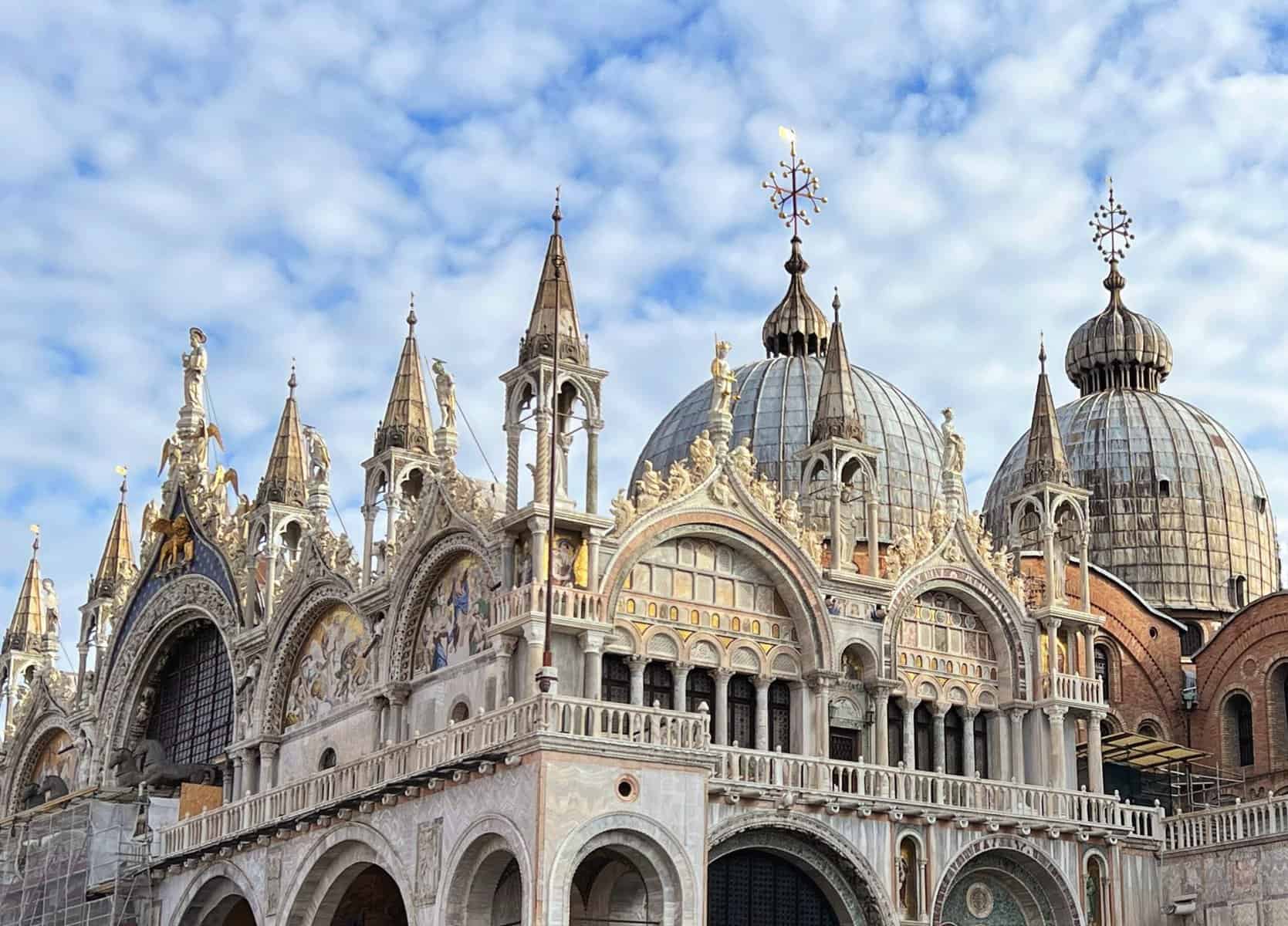A Guide to Venice’s Eclectic and Historic Churches
Church-hopping can be one of the best ways to experience Venice. We discovered nearly all of our favorite spots in the city while tracking down various masterpieces in stone and paint. Churches are probably the least predictable building type in the city – and also the most overlooked. Facades spanning more than a millennia shelter everything from submerged crypts to wineries, complimented by Old Master paintings and contemporary art installations. Most are free or inexpensive and with the exception of Saint Mark’s, they never seem to get crowded.
La Serenissima’s stability over the centuries has made it possible to sponsor an incredible amount of art and architecture; in spite of its tiny size, Venice’s density can be overwhelming. We’ve put together a list of key churches which exemplify this most exceptional city and provide a way to navigate its many layers. They include swampy hideouts from the Dark Ages and bombastic memorials celebrating ruthless leaders of a far-flung empire. No matter the era, worldly Venetians have always brought a unique sense of style to their churches.

Our list includes major and minor monuments chosen from over 130 churches in Venice’s main cluster of islands. In order to reflect the city’s evolution, we present them mostly by their traditional founding dates. All sites are marked on our Google map.
While a handful of churches require individual tickets, the rest are either free to visit or included on the Chorus Pass. The €14 ticket covers entry to 20 churches and can be purchased on the spot at the entrance of any participating site. For more information, see the website.
Origins: Torcello Island
Early Churches in Venice: San Giacometto and the churches of San Magno (San Zaccaria, San Giovanni in Bragora, San Pietro di Castello, Santa Maria Formosa)
Medieval Venetian Churches: Saint Mark’s Basilica, San Giacomo dall’Orio, San Polo, San Martino in Castello
Venetian Gothic Churches: Santa Maria Gloriosa dei Frari, San Zanipolo (Santi Giovanni e Paolo), Madonna dell’Orto, Sant’Alvise
Renaissance Churches in Venice: San Maria dei Miracoli, San Michele in Isola, San Giorgio dei Greci, San Sebastiano, San Rocco, San Francesco della Vigna, San Giorgio Maggiore, Il Redentore
Baroque Churches in Venice: Santa Maria della Salute, San Moisè, Santa Maria del Giglio, I Gesuiti (Santa Maria Assunta), Santa Maria di Nazareth (Chiesa degli Scalzi)
Conclusion and Further Reading
Origins: Torcello Island
One of Venice’s great ironies is that it began as a hiding place chosen specifically for its undesirability. Fifth-century citizens of the collapsing Roman Empire used the near-impenetrable malarial swamp as a place to hide from invaders like Attila the Hun.


These origins are preserved on the island of Torcello, home to the lagoon’s first major settlement. By 639, the population had stabilized enough to begin construction of a cathedral. In spite of later modifications, Santa Maria Assunta retains its original form, which John Ruskin likened to an ark. Mosaics dating back to the 11th century are the oldest and most characterful in greater Venice. A striking Madonna commands the apse, facing a phantasmagorical Last Judgement in which grinning blue devils and a naked sea goddess watch angels rescue souls from the maws of sea-serpents.

Ultimately, rising water levels and successive plagues wreaked havoc on Torcello. Residents of the Rialto and other islands helped themselves to free materials from its increasingly abandoned buildings. Today visitors can climb the campanile and view a landscape not dissimilar to what Bishop Paul might have seen from an earlier tower 1500 years ago.


The site also includes the 11th-century church of Santa Fosca and a small museum. Nearby, the erroneously-named Attila’s Throne is an ancient stone chair probably used by early governors.
Early Churches in Venice
San Giacometto
According to legend, the Republic of Venice officially began on March 21, 421, when the San Giacomo di Rialto was consecrated. The earliest record of the church dates to 1152, and the layout of the present structure probably dates to this period. A modestly-sized floor plan in the shape of a Greek cross topped by a dome emphasizes the early city’s Byzantine heritage. In spite of multiple renovations over the centuries, traces of the older church remain. Most notably, the interior retains its original Greek marble columns and capitals, as well as altars dedicated by the merchants who worshipped here – including a 12th-century inscription admonishing them to be honest in their trade.

Tucked between the market and the Rialto Bridge, the church maintains a presence largely thanks to a famously-inaccurate clock added in 1410. The façade features a wooden portico – one of just two to survive after the city switched to less-combustible materials. (Venice’s density made it peculiarly vulnerable to fires.)
Open Monday-Saturday 9-5. The church sometimes hosts concerts (usually Vivaldi) in the evenings.
The Churches of San Magno
A large number of refugees arrived in Venice around the year 650. According to legend, San Magno founded no fewer than eight churches in the vicinity around this time: Santi Apostoli, Santa Giustina, San Salvador, and Angelo San Raffaele, plus the four we cover below. Funded and controlled by local residents, these smaller churches are inextricably linked with neighborhood histories. For visiting information, see the Chorus Pass website.
San Zaccaria


Historical records for the church begin in 828. The current façade shows Venice transitioning into Renaissance architecture. An older interior includes a permanently-flooded and highly atmospheric crypt with the tombs of eight early doges. Paintings include work by the three T’s (Titian, Tintoretto, and Tiepolo) and a Van Dyck. Pride of place goes to Bellini’s Madonna, perhaps his finest altarpiece. Like many works of the era, the painting echoes the architecture around it to create an illusion of depth.
San Giovanni Battistà in Bragora

Allegedly founded in the seventh century and first documented in 1090, the current Church of San Giovanni in Bragora dates to 1475. Although Gothic in style, the façade’s austerity matches early Renaissance structures in Florence. Inside, a rare ship’s-keel ceiling arches over a collection of ancient columns looted from the eastern Mediterranean. A plaque notes Vivaldi’s baptism here; fans of the composer can also visit the nearby Santa Maria della Visitazione (a.k.a. la Pietà) where he worked for many years.
San Pietro di Castello
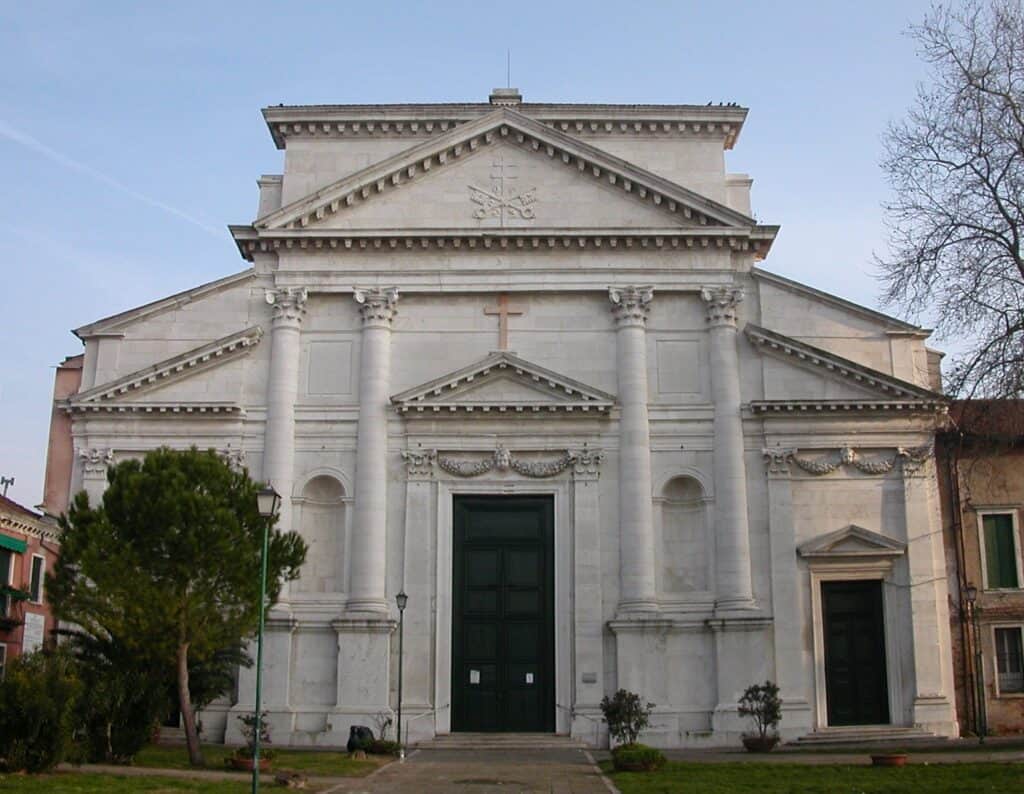
Always wary of Roman interference, Venice literally kept papal representatives as far from the city center as possible. All the way out on the island of San Pietro di Castello, the church of the same name was the city’s official cathedral until 1807. Besides Palladio’s 16th-century façade, the church features a Veronese and some early Christian artifacts. The snow-white bell tower originally had a dome on top.
Santa Maria Formosa
Formosa translates to “buxom”, which is apparently the form assumed by the Virgin Mary when she appeared to St. Magnus and instructed him to build a church in her honor. Early records date to 1060, and the original church’s dimensions were preserved through multiple rebuilds.


On the base of Santa Maria Formosa’s bell tower, a famous grotesque with facial growths evokes the plague. Venice’s density made it particularly vulnerable to epidemics, prompting the world’s first quarantine regulations. The term “quarantine” refers to quaranta (40), the number of days in a standard isolation period.

Early-Renaissance architect Mauro Codussi brilliantly fused Byzantine and Latin traditions in his floorplan; unfortunately his designs for the exterior were lost after his death midway through construction.
Medieval Venetian Churches
By the close of the eighth century, the Pope had thrown in his lot with the “barbarian” Franks to create the fledgling Holy Roman Empire. Venice chose to follow the money, trading with communities from northern Africa and much of Asia. The nascent city-state maintained its independence through clever alliances, above all with the powerful Byzantines. Venetians profited handsomely from the Crusades, infamously masterminding the sack of its former allies in Constantinople. In 1204, the Venetian Republic became the Venetian Empire.
Saint Mark’s Basilica
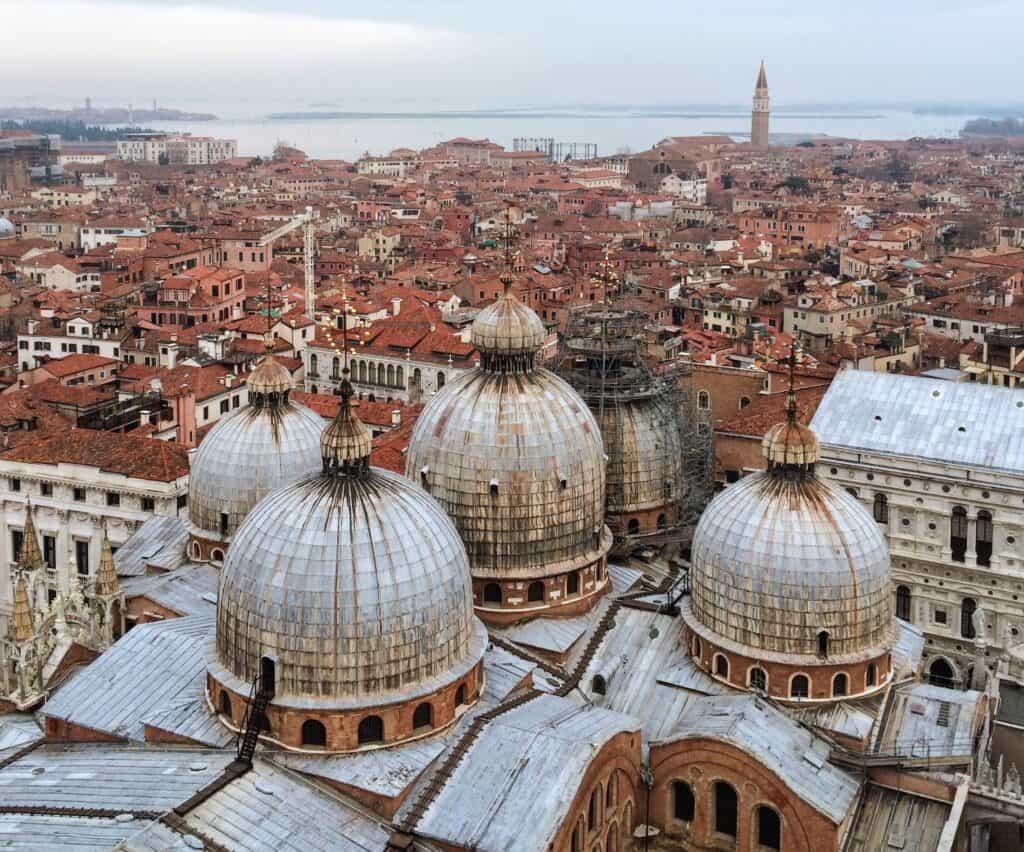
Saint Mark’s Basilica is the most symbolic building in Venice – and it’s every bit as exceptional as the city itself. A treasure-house as well as a church, it was the scene for all manner of politics and pageantry for over a millennium. Legends focus less on the saint than the craftiness of the sailors who smuggled his remains out of Alexandria, packed under a layer of pork to deter Muslims. Until the 19th century, Venice’s leading church was the Doge’s chapel rather than the cathedral, avoiding the latter’s position of subservience to Rome.


Above all, Saint Mark’s embodies the ties between Venice and Constantinople. Venetians proclaimed their allegiance to the Byzantines by adopting their architecture: the basilica’s layout features five bulbous domes topping four equal arms instead of an elongated Latin-style nave. Golden mosaics and veneers of inlaid marble provided a backdrop for ancient columns, gem-encrusted altars, and priceless relics – not to mention an infamous set of bronze horses pilfered from Istanbul’s Hippodrome. Ironically, it’s nearly impossible to distinguish between elements which respectfully emulated Byzantine splendor and pieces which Venetians looted from Constantinople in 1204. The betrayal of its old ally still shadows this church, even as tour companies breathlessly point out the “REAL GOLD” elements.


The first church on the site was begun in 829 but largely destroyed in a rebellion, while the second version was ruined in a fire. The third and final version of the structure was begun in 1063 and evolved continually ever since. Today, it exists in a more or less permanent state of restoration under its own team of experts.
See the website for visiting information.
San Giacomo dall’Orio
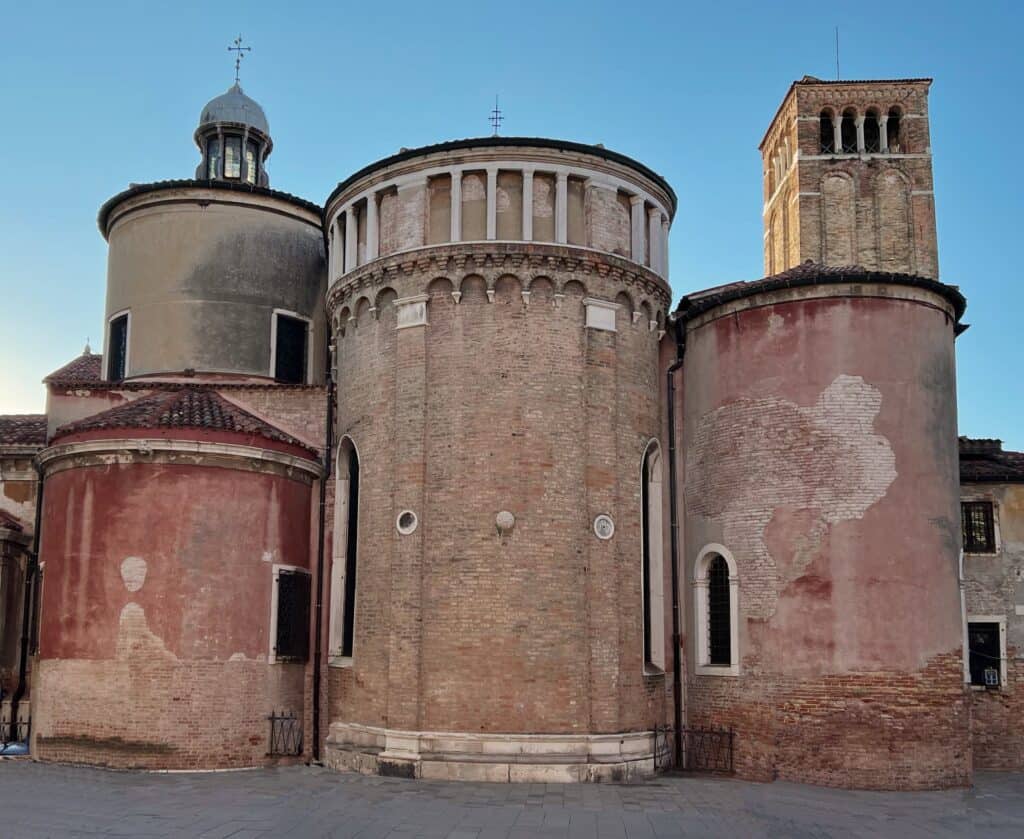
Founded in the ninth century and rebuilt around 1225, San Giacomo dall’Orio underwent various modifications over the years. Amongst treasures pillaged from Constantinople during the Fourth Crusade is a famous green marble column; the real highlight of the building, however, is the striking wooden roof system shaped like a ship’s keel. The surrounding piazza functions as a play area and social hub for residents and their canines.
For visiting information, see the Chorus Pass website.
Chiesa di San Polo


In a city with so much opulence, the unassuming architecture of the Chiesa di San Polo is refreshing. Instead of passing through a grand façade, one enters the church through a side portal. Some parts of the structure go back to the ninth century, including the ship’s-keel roof. Besides paintings by Veronese and Giambattista Tiepolo, the San Polo houses an entire cycle by the latter’s son.
For visiting information, see the Chorus Pass website.
San Martino di Castello


Dating to at least 932, the Church of San Martino di Castello once ministered to the neighborhood’s dock workers. Although they managed to obtain a design from the famed Jacopo Sansovino – architect of the Library and Loggetta on St. Mark’s Piazza – the poverty of the parish extended construction of the interior to nearly 80 years.

A façade added in 1897 retains the Renaissance doorway and one of the old bocca di leone, “lion’s mouth” boxes where Venetians could report misdeeds to the government anonymously.
Venetian Gothic Churches
In the 13th century, new monastic orders focused on skyrocketing urban populations. Dominicans and Franciscans brought the Gothic style with them to Venice. Italians never fully embraced the style, and Venice had even less use for it than most of the peninsula. The heavy stone piers and buttresses required to support soaring vaults would never work on the lagoon’s marshy landscape. Walls of stained glass were also impractical – not to mention incongruous against Venice’s rich Byzantine heritage and Islamic influences. The city incorporated some decorative elements from Gothic structures, most notably pointed arches, into its own distinctive building style.
Santa Maria Gloriosa dei Frari
The Franciscan Frari began construction in the mid-13th century. In order to reduce the massive structure’s weight, its builders adopted the Lombard tradition of using brick rather than stone. Because the monks swore vows of poverty, they favored austere rather than ornate exteriors.


Titian’s memorial (above) and Assumption of the Virgin in the apse (below)


The combination of brick and white stone provides the perfect backdrop for the wealth of artwork. Major artists working on the grandest of scales vie for attention, from the funerary monuments lining the nave to Titian’s gargantuan altarpiece. Smaller masterpieces such as Donatello’s wooden St. John the Baptist spill out from the crossing.
For visiting information, see the website.
Santi Giovanni e Paolo (San Zanipolo)
The Dominicans acquired the land for their church in 1246; by 1333, they were scrapping it to accommodate the order’s growing size and prestige. Rivaled only by the Frari church for Gothic grandeur, the Basilica dei Santi Giovanni e Paolo (or Zanipolo) combines uniquely Venetian architecture, art, and history. On the exterior, a late-Gothic portal incorporates columns salvaged from the ancient settlement on Torcello island.


Inside, gentle light from the rare original stained-glass windows softens the contrast between the raw brick walls and white stone accents. Like the Frari, the church exhibits a few Venetian peculiarities. For instance, unstable ground required the addition of cross-beams for the vaults. Instead of minimizing them, the Venetians decorated them with characteristic flair.
Besides the roll-call roster of painters and sculptors who contributed to the church, the San Zanipolo is famous for its memorials. From the 15th century on, this was the site of ducal funerals and burials. 25 doge’s tombs – the largest group anywhere – range from austere to over-the-top.
For visiting information, see the website.
Madonna dell’Orto
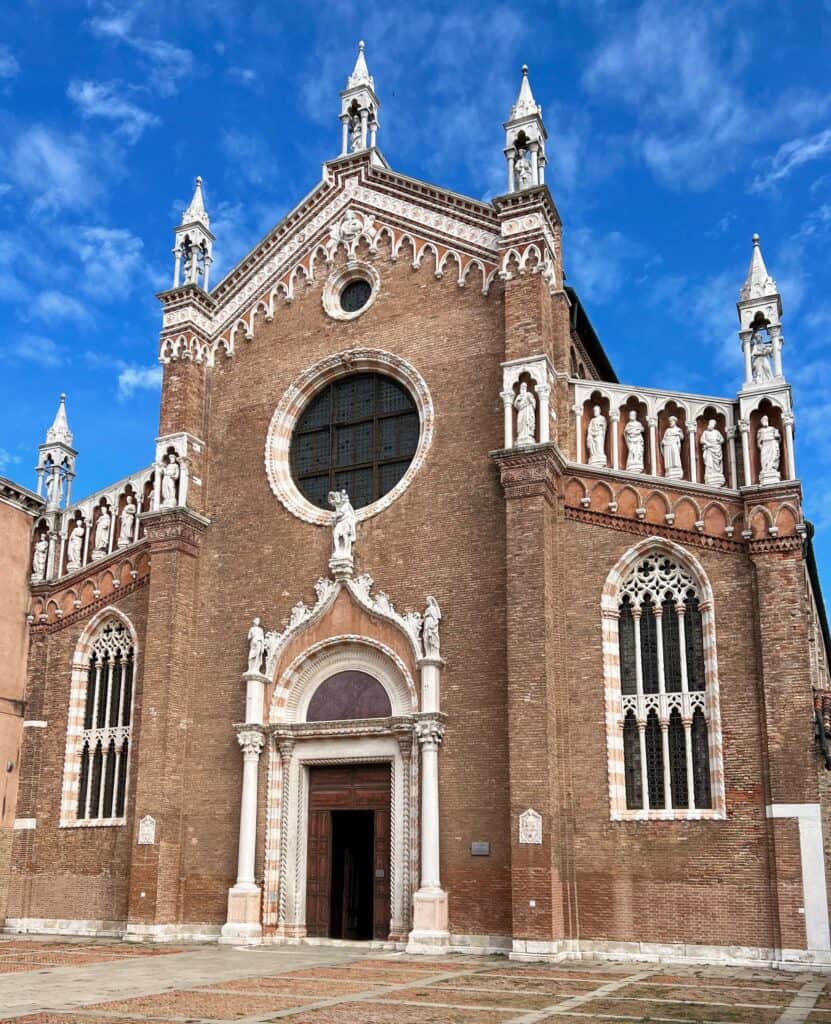
One of the loveliest Gothic churches in Venice, the Madonna dell’Orto is best known for its links to Tintoretto. The local artist painted some of his most arresting works here, including the monumental altarpieces. Along with the Scuola Grande di San Rocco, this is the best place to see his work. Visitors can pay respects to his tomb: Tintoretto’s family was also buried here, including a daughter who painted.
Side chapels dedicated to powerful Venetian families house more art, including a Titian. Bellini’s “Madonna With Child” was stolen from Valier Chapel for third time (!) in 1993.
For visiting information, see the Chorus Pass website.
Church and Convent of Sant’Alvise
Once an integral – if mysterious – part of Venetian life, most of the city’s numerous convents were eventually closed. On the northwestern edge of Cannaregio, Sant’Alvise offers a rare glimpse into the “pleasant prison” inhabited by so many women.


Venice’s unusually low marriage rates (less than 50% for the nobility) led to the creation of dozens of nunneries, with varying levels of autonomy. Founded in 1388 by doge’s daughter Antonia Venier, Sant’Alvise retains most of the convent’s original layout. The church houses a Tiepolo triptych.
For visiting information, see the Chorus Pass website.
Renaissance Churches in Venice
By the end of the 15th century, several developments signaled major changes in Venice’s international position. Ottoman Turks were taking over Mediterranean trade, the Portuguese opened their own naval routes to east Asia, and Columbus discovered a new continent – it was the beginning of the end for the Venetian Empire. Henceforth the city began to focus more on mainland Italy, and its architecture began to align with the Renaissance style found across the lagoon.
San Michele in Isola
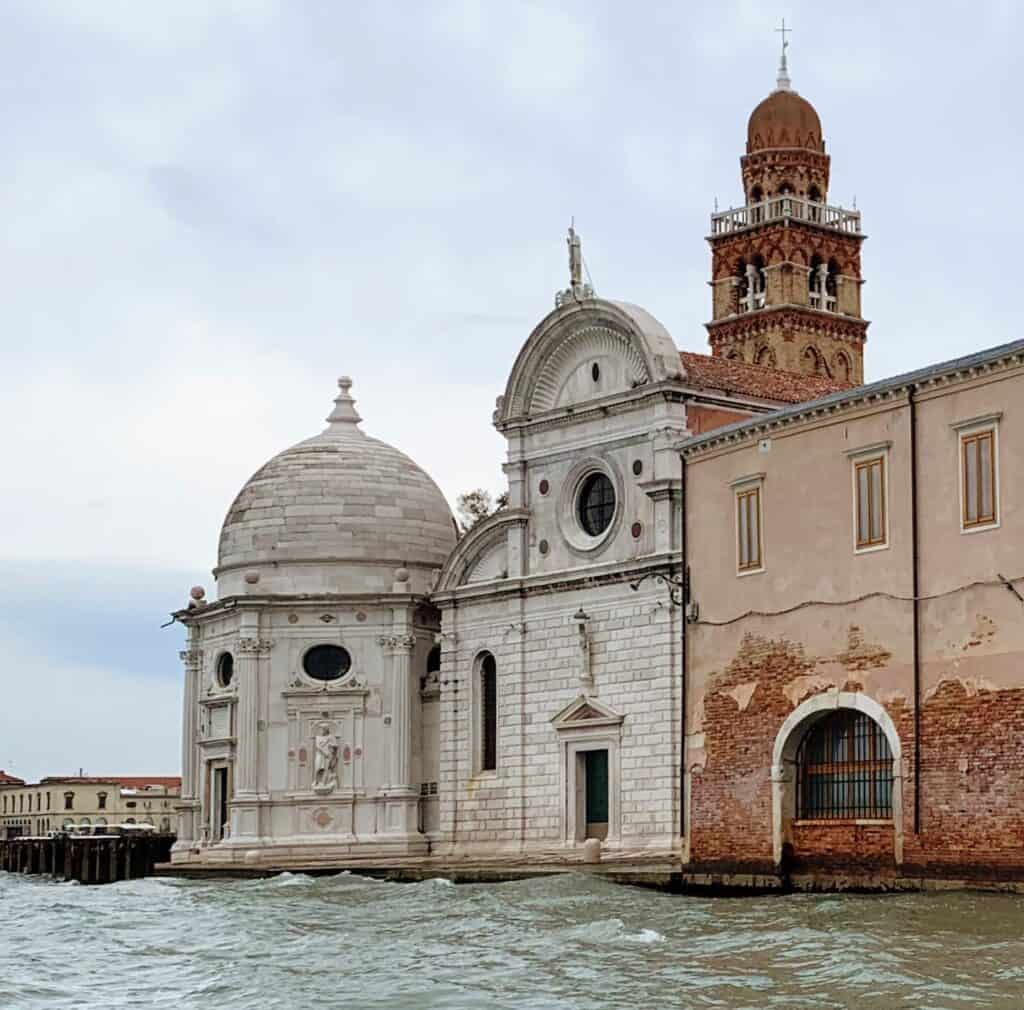
North of Cannaregio, the cemetery island of San Michelle makes a peaceful getaway. At the Church of San Michele in Isola, architect Mauro Coducci created a uniquely Venetian version of the Renaissance style, and his sparkling white façade on the church here would later inspire Palladio’s work.
Cemetery hours April-September 7:30-6, October-March 7:30-4. The church follows the same schedule but closes between 12 and 3.
Santa Maria dei Miracoli
This is one of the most beloved churches in Venice. Descriptions of the Santa Maria dei Miracoli inevitably include the words “jewel box” – and for good reason. Built in 1491 to house an allegedly miraculous painting of the Virgin Mary, the Miracoli features a simple, dramatic layout.


The Madonna rests on a high platform above a monumental staircase, sheltered by a coffered wooden barrel vault. There are no frescoes to compete with the painting, just patterned marble walls and statues.
For visiting information, see the Chorus Pass website.
San Giorgio dei Greci


On the left: the San Giorgio dei Greci’s tilted bell tower. On the right: the iconostasis, photo courtesy of Wikimedia Commons.
Refugees from Byzantium poured into Venice after the Ottoman conquest in 1453. The Greek population swelled, exceeded in size only by the Jews. In 1526, the city granted permission to practice Eastern Orthodox worship, and soon after the community erected the church of San Giorgio dei Greci. The Renaissance-style interior holds an elaborate golden iconostasis (icon screen).
San Sebastiano
Venice developed a reputation as the destination of choice for anyone fleeing persecution, be it from an abusive husband or the law. The artist Paolo Veronese belongs in the latter category: legend says he used this church as a sanctuary after being charged with murder in Verona in 1555. Apparently he was grateful enough to spend decades painting the walls, ceiling, organ doors, and more. A handful of other masters contributed work to the interior, among them Titian, Tintoretto, and Sansovino.


San Sebastiano’s spare Renaissance facade dates to the first half of the 16th century. The site originally held a hospice and oratory, which were converted into a church in 1468.
Saint Sebastian’s martyrdom involved being shot by arrows, and in medieval times his wounds were likened to plague swellings. He grew into one of the major patrons for defense against the plague, and his church is one of five votive (thanksgiving) structures in Venice. (The others are San Giobbe, San Rocco, Il Redentore, and Santa Maria della Salute.)
For visiting information, see the Chorus Pass website.
San Rocco
Middle-class Venetians exercised political power via scuole, charitable organizations which grew into a de facto welfare system. The most powerful of these became known as scuole grandi, and their wealth allowed them to become major artistic patrons during the Renaissance.


Belief in San Rocco’s power to ward off plagues attracted mass donations to the Scuola Grande di San Rocco, and the institution quickly grew into the richest of its kind. Founded in 1478, the Scuola was able to finance construction of both a new church and a new headquarters within just a few decades. In 1725, the San Rocco church had to be rebuilt due to structural instability; the new version deliberately echoed the dimensions and forms of the headquarters. Tintoretto famously won the commission to decorate the buildings. The church has six of his paintings, making it less overwhelming than the scuola itself (with more than 50).
Monday-Saturday, 9:30-5:30; the church is also open Sunday 1:30-5:30. Admission: Scuola €10, church €2.
San Francesco della Vigna
On the less-travelled northern edge of Castello lies the former monastery of San Francesco della Vigna. According to legend, an angel visited Saint Mark on this spot, predicting the rise of a city honoring him. In 1253 Franciscans replaced the chapel here with a church, naming it after the surrounding vineyard (vigna).

A reconstruction begun in 1534 used a design by Jacopo Sansovino with modifications by the prior. The outsized scale of Andrea Palladio’s 1568 façade is a surprise on such a compressed site. His groundbreaking design used different scales to distinguish their layers and similar shapes to unite them.
Besides work by Veronese and Tiepolo, the church also features a lovely set of cloisters – something of a rarity in densely-built Venice. In recent years, the vineyard has resumed wine production, selling bottles under the label Harmonia Mundi.
San Giorgio Maggiore

Andrea Palladio, the most-imitated architect of the Western world, began to transition from the neighboring city of Vicenza to Venice in the late 1550’s. San Giorgio Maggiore was his first opportunity to design an entire church. Its careful positioning showed an exceptional understanding of the city’s unique landscape. He factored in the church’s appearance from across the entire basin as well as the effects of light on the water. By continuing the Venetian tradition of cladding buildings in pure white marble, he ensured that his design would harmonize with its surroundings.

In a radical decision, Palladio continued the all-white palette of the façade on the interior. Italians traditionally covered the insides of their churches with frescoes. Palladio, however, claimed that white’s purity would be more pleasing to God. It’s probably not a coincidence that he found patrons to approve his scheme in Venice, long known for its progressive taste and willingness to push at Rome’s ecclesiastic norms.
Open April-October 9-7 & November-March 8:30-6, closed during Sunday Mass.
Il Redentore
Il Redentore, on the adjacent island of Giudecca, gave Palladio an opportunity to refine his new church model. The major distinction between the San Giorgio Maggiore and the Redentore relates more to their patronage than their design. The Senate pledged to build a large church in thanks to Il Redentore (“Christ the Redeemer”) for the end of a devastating outbreak of the plague in 1576.


The basin in front of San Marco had long been the center of aquatic spectacles, and the new church extended the grand theater out to encompass Giudecca Island. It also added another major event to the calendar, in which the Doge and other dignitaries crossed a temporary bridge of boats to pray in the church.
Venice still celebrates the Festa del Redentore procession across the basin, complete with fireworks, every third Sunday in July. Other than occasional events like weddings, the church stays quiet for the rest of the year. The gardens next to the church were reopened in October 2024 after extensive restorations.
For visiting information, see the Chorus Pass website.
Baroque Churches in Venice
Venice’s often-strained relationship with Rome survived the Counter-Reformation, although the city flirted heavily with Protestantism. As usual, Venetians didn’t adopt the Baroque style wholesale. They appreciated its dynamic forms and sensitivity to urban context, but disdained attempts to manipulate emotions with theatrical effects.
Santa Maria della Salute
Baldassare Longhena’s proposal for the Santa Maria della Salute referred to the design as a rotonda machina: a round version of the elaborate floats used in the city’s regattas. A votive church, it was commissioned in gratitude for the city’s deliverance from the plague – in this case, the epidemic of 1630. Like the Redentore, it serves as the culmination of an annual aquatic procession, this one across a pontoon of boats from the Santa Maria del Giglio on November 21.
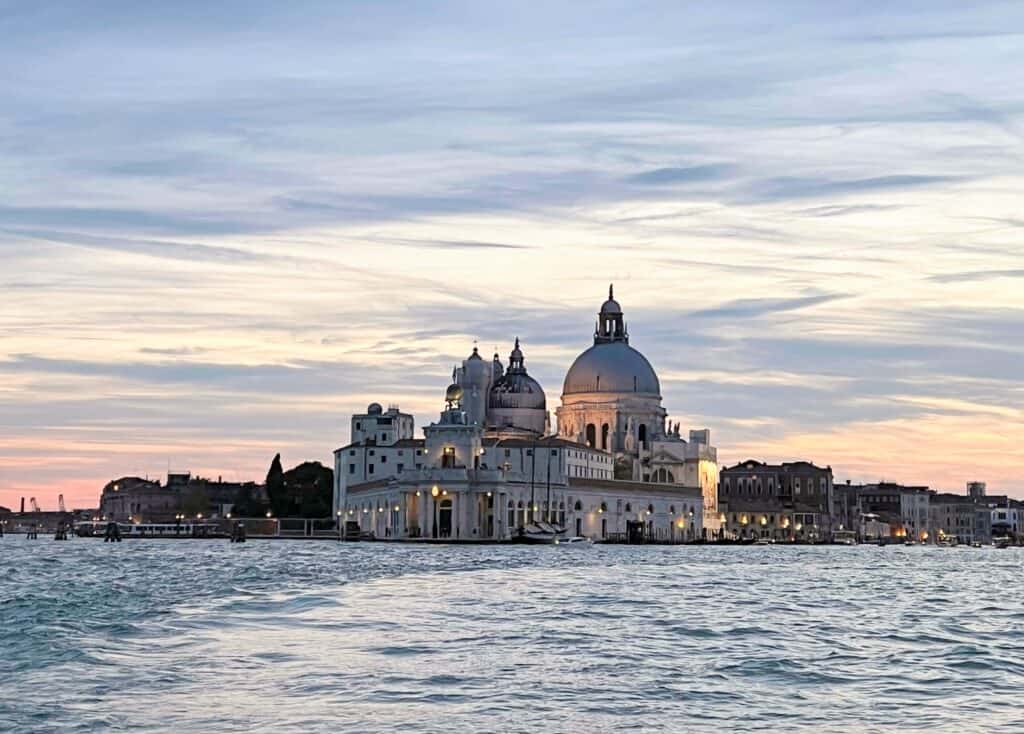
Longhena’s design exploits the best piece of real estate in the city. Its round design shows to advantage from any perspective, as demonstrated by Monet, Sargent, Turner and countless artists. Oversized spirals around the base of the towering dome add liveliness, while the innovative interior whirls around an open center. With multiple Titians, a Tintoretto, and other artwork, the church and adjoining sacristy rival many museums.


Santa Maria della Salute would be the last of Venice’s great churches. In spite of the Republic’s determination to maintain its status on the world stage, such projects were increasingly difficult to fund. Even the foundations were a major undertaking: records indicate 1,156,627 wooden piles were driven into the mud. (The actual number is probably a tenth of that, but still formidable.)
San Moisè
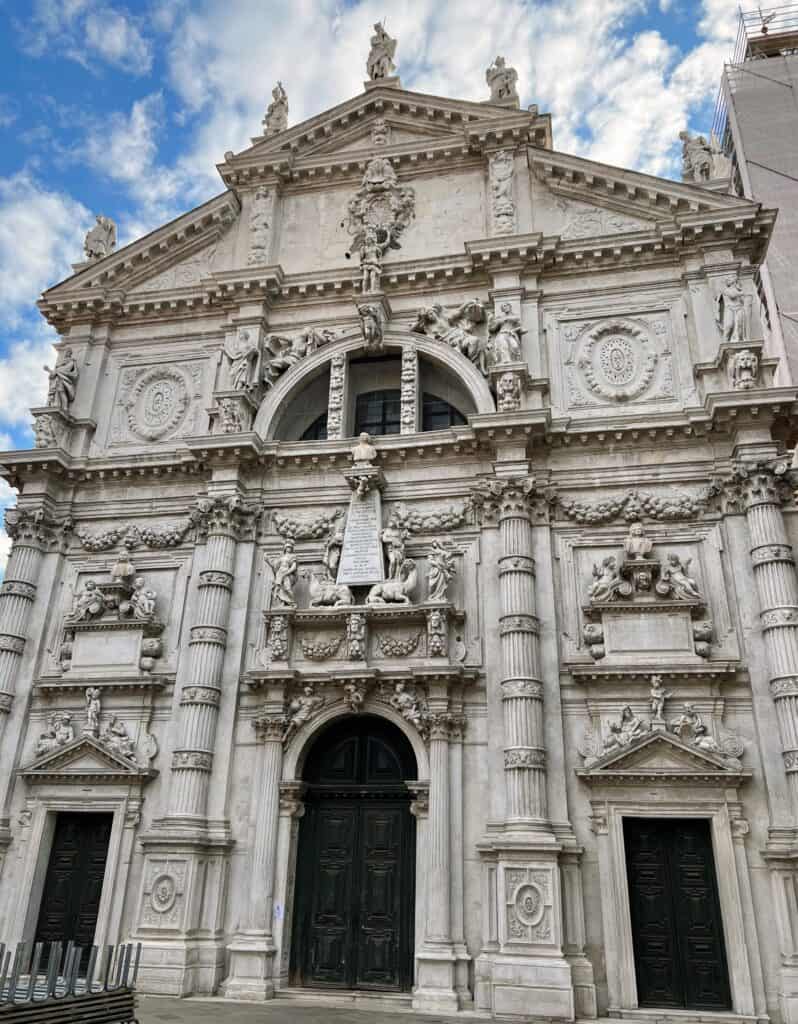
Several churches came and went on this spot between the late eighth century and the present incarnation. By 1668, many wealthy Venetian were more interested in celebrating themselves than Christianity. Vicenzo Fini circumvented the ban on statues in public spaces by sponsoring work on San Moisè and getting his bust on the church’s somewhat fussy facade. The interior features a requisite Tintoretto along with an odd altarpiece which attempts to fuse painting and sculpture.
Santa Maria del Giglio (Santa Maria Zobenigo)


Poor Madonna-of-the-Lily didn’t even make it onto the front of her own church after a certain Admiral Antonio Barbaro was finished. Along with financing for its reconstruction, he provided a whole list of specifications for its design – including relief maps of six cities he served in, as well as sculptures of himself (front and center) and his family. Architect Giuseppe Sardi managed to produce a lively facade which brings some playfulness to the posturing. Inside, the artwork includes a Tintoretto and the city’s sole painting by Rubens.
Technically the Santa Maria del Giglio was founded in the ninth century, but it is normally classified by its reconstruction date, 1678-81. For visiting information, see the Chorus Pass website.
I Gesuiti (Santa Maria Assunta)
The site’s original monastic complex, built in 1155, included a hospital for Christian pilgrims and warriors en route to and from the Holy Land. In 1657 the cash-strapped Venetian Republic sold the property to the Jesuits. The facade isn’t the most interesting, but the interior takes the native fondness for illusions to unprecedented lengths. Even critics like John Ruskin found the trompe l’oeil marblework intriguing, although another writer described the building as “table-clothy”. Besides marble curtain swags and damask-wrapped columns, the church houses one of Titian’s most powerful paintings (the Martyrdom of Saint Lawrence) and an early Tintoretto. Note: the Gesuiti (a.k.a Santa Maria Assunta) is easily confused with the Gesuati (a.k.a. Santa Maria del Rosario, an 18th century church in Dosoduro).
Santa Maria di Nazareth (Chiesa degli Scalzi)
Both of Venice’s most accomplished Baroque architects contributed to the Scalzi church: Giuseppe Sardi created the façade, and Baldassare Longhena designed the structure behind it. Unlike his plan for the Santa Maria della Salute, where a simple layout anchors the ornate décor, Longhena’s work here is a tidal wave of grape marble and gilt.
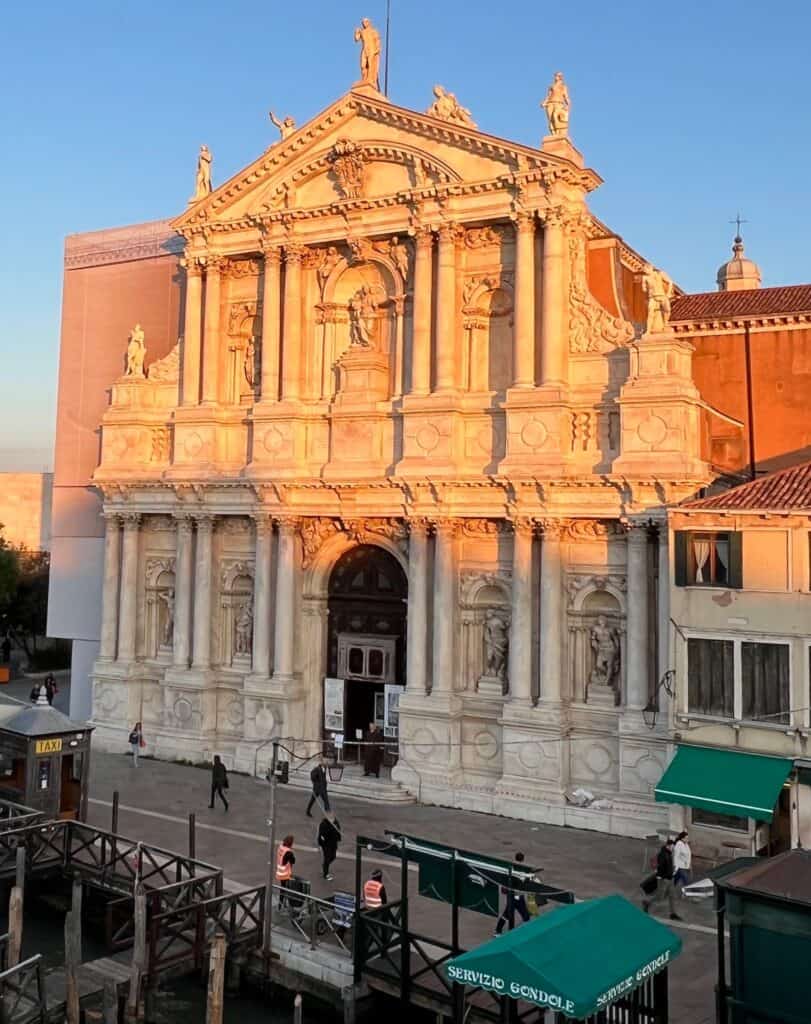
The Scalzi is one of the last Baroque façades in Venice; the Republic’s declining fortunes would soon be reflected in severe, restrained NeoClassical architecture. Tiepolo painted the ceiling vaults, and the side chapels dedicated to noble families include the tomb of Venice’s last doge, Ludovico Manin. After the “oh my” interior, the large garden behind the church is surprisingly serene. The grapevines yield about a thousand bottles’ worth of wine per year.
Open daily 7-1 & 2:30-6:45.
Conclusion and Further Reading
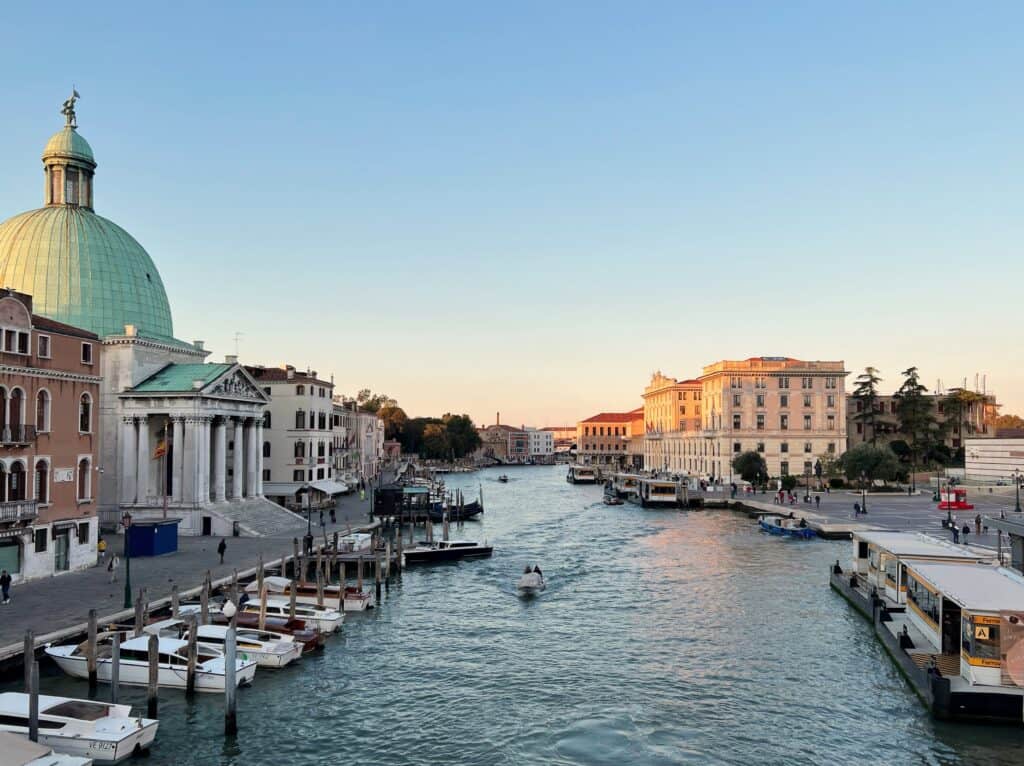
As Venice’s fortunes steadily deteriorated in the 18th century, church construction dwindled. By the time Napoleon officially ended the 1100 year-old Republic in 1797, tourists were already beginning to replace residents. As showcases for art both old and new, however, La Serenissima’s churches live on.
Our other posts on Venice include:
Palladio’s Architecture in Venice
A Guide to Venetian Gothic Churches and Palazzos
Cannaregio, Venice’s Most Relaxing District
Venice’s San Polo District: The Rialto and Beyond
Staying in Santa Croce, Venice’s Most Authentic District
Castello: Venice’s Sestiere of Secrets
For more on mosaics, see our post Italy’s Most Stunning Mosaics From Rome to Ravenna to Sicily.

